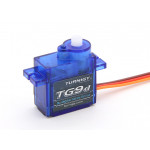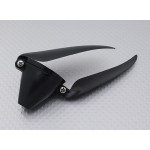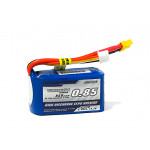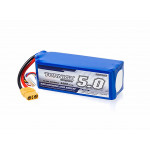
We’ve all seen the guy who runs like an aging warrior with a spear at the ready, determined to launch his spear into a close earth orbit. In reality, his sprint falls short and he tosses the glider like he has given up the will to live. Never was there a greater anticlimax!
Hands up who has seen a botched hand launch so sketchy it smashes into the ground full throttle ripping the front end clean off? Hands up if you found it somewhat amusing? To top it off, I’ve seen someone repeat the mistake in a space of minutes. Whilst it can be amusing to the peanut gallery, it’s really not much fun for the poor guy just trying to have a go.
 So it can’t be that hard, right? Well, depends on what you’re trying to launch, as some planes are very easy to launch and others quite tricky. A plane like the Hobbyking Bixler is an excellent beginner to intermediate aircraft due to its light wing loading and simple design. A gentle toss forward with the throttle at 75% is all this is required.
So it can’t be that hard, right? Well, depends on what you’re trying to launch, as some planes are very easy to launch and others quite tricky. A plane like the Hobbyking Bixler is an excellent beginner to intermediate aircraft due to its light wing loading and simple design. A gentle toss forward with the throttle at 75% is all this is required.
Whilst it’s fine to hand launch an aircraft at a shallow incline, anything beyond this is fraught with danger. This is because the aircraft is more likely to stall at this point. A shallow incline will allow the aircraft to build speed quickly and shortly after you can begin to climb out. There are of course exceptions. Some planes have straight up a vertical performance like the Durafly Excalibur. That plane will launch straight out of your hand at a near-vertical ascent.
EDF Jets need extra care. This is because a stall condition is very easy to enter. The control surfaces of the aircraft are only effective so long as air moving over them. If launched too sharply the aircraft will lose speed quickly, stall, and become uncontrollable. Notice this guy has launched the aircraft many times however the angle was much shallower. On this occasion, he tossed it into the air at a steep angle causing the aircraft to stall and crash.
The good news is that taking off or hand launching isn’t usually too difficult provided you understand the basics. Remember that takeoffs are optional, landings are mandatory!
Hand Launching Tips
- Check your CG
- Check your control surfaces and direction of travel
- Check wind direction
- Forcefully launch the aircraft with power into the wind level or at a shallow incline
- Allow aircraft speed to increase before climbing out too steeply
- Extra attention needed with EDF aircraft.
Rolling of Ground
If your aircraft is equipped with landing gear then you may be able to hand launch or take off from the ground. Don’t expect to be hand launching a 2300mm L3 Cub. Many smaller 70mm EDF jets and 1200mm foamies can be hand or ground-launched. Planes fitted with landing gear are best flown from a well-maintained strip or tarmac, however, larger wheels open the options somewhat. The ever-popular Durafly Tundra can be flown from just about anywhere and even launched by hand. The large wheels allow the plane to be landed on rough surfaces and the floats/skis offer additional take-off options. water or snow of course.
Taking off should be a simple process that is easily repeatable, however, some planes are more tricky than others. Most aircraft will taxi well and track straight down the strip without too much difficulty. There are of course the recalcitrant aircraft that do not wish to be ruled and have a mind of their own. We can either learn to live with those idiosyncrasies, attempt to correct it, or perhaps a little bit of both.
Taxiing an Aircraft
If your pride of the fleet does not currently taxi well then it’s not going to track well for a takeoff. Identify and correct the issue. Main wheels should have a slight toe-in, this helps the aircraft tracking straight. If the aircraft veers the angel causes additional friction pulling the aircraft back to the center. Toe-out will have the opposite effect causing the aircraft to become difficult during takeoff.
A misaligned nose wheel can be overcome by steering the aircraft down the strip. As the aircraft build speed, the nose wheel becomes ineffective and the rudder is actually moving the aircraft. You cannot trim out the nose wheel as it will also move the rudder. Adjust the nose wheel via the servo clevis or servo stop. If the nose wheel and rudder are on different channels some radios can manually move a servo. For example, the Taranis has this functionality.
If you have completed all pre-flight checks you can begin to taxi out for a takeoff. The aircraft should be facing directly into the wind (if the wind is present). You must take off into the wind as much as you must land into the wind. If you take off with the wind it means you will require a much faster take-off speed and it's possible that you may stall.
 Slowly apply throttle to keep the aircraft tracking straight as it travels down the strip. Avoid sharp steering movements by holding the position and releasing it gently as the rudder gains authority. Generally, a takeoff uses anywhere from 70% to 100% throttle and on a new aircraft ALWAYS uses 100% until you get a feel for how it flies. As the aircraft reaches maximum speed slowly start pulling back on the elevator and the aircraft will begin to rotate and lift from the runway. Keep the aircraft on a gentle incline and retract the landing gear as soon as possible. This reduces drag and allows the aircraft to reach the optimum speed sooner. Do not try to take off too early as the aircraft may stall and crash. You will eventually get a feel for the plane over several flights.
Slowly apply throttle to keep the aircraft tracking straight as it travels down the strip. Avoid sharp steering movements by holding the position and releasing it gently as the rudder gains authority. Generally, a takeoff uses anywhere from 70% to 100% throttle and on a new aircraft ALWAYS uses 100% until you get a feel for how it flies. As the aircraft reaches maximum speed slowly start pulling back on the elevator and the aircraft will begin to rotate and lift from the runway. Keep the aircraft on a gentle incline and retract the landing gear as soon as possible. This reduces drag and allows the aircraft to reach the optimum speed sooner. Do not try to take off too early as the aircraft may stall and crash. You will eventually get a feel for the plane over several flights.
If you are taking off in a crosswind, be prepared to use the rudder to correct yaw (Left-Right) and the ailerons to compensate roll. Be prepared for the plane to want to lift a wing as soon as it leaves the ground. Crosswind takeoffs can be tricky but practice makes perfect and as you become a more accomplished pilot you can practice crosswind landings. At some point, you may well be caught in a sudden crosswind and need to land. This is when you’ll be glad you had spent a few weekends practicing on a worn-out airframe.
Depending on the type of plane the length of the runway will vary. For example, an EDF jet will require a substantially longer runway than a tundra. Again, as you become more familiar with your aircraft you will be able to judge the amount of runway required.
Ground Launch Tips
- Check your CG
- Check control surfaces and direction of travel
- Check your landing gear closes freely
- Check your wheels rotate without binding.
- Toe-in is useful. Toe-out is a hindrance.
- Check wind direction
- Point the aircraft into the wind
- Apply throttle slowly moving through to full throttle
- Keep the aircraft tracking straight
- Allow aircraft speed to increase before climbing out
- Climb out gently and retract gear as soon as possible
- Beware of crosswind takeoffs.
- Be prepared for adverse yaw or roll
- Extra attention needed with EDF aircraft.
Written by gozerian
Hear it First: Join our Mailing List
Sign up to receive new product updates, exclusive discounts, news, and more!






